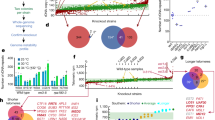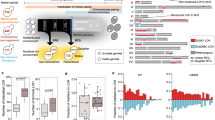Abstract
COMPARING X-ray inactivation curves of haploid and diploid strains of Saccharomyces, Latarjet and Ephrussi1 were the first to suggest that radiation inactivation of yeast cells may be caused by an induction of recessive and dominant lethal mutations. The first evidence of X-ray-induced recessive and dominant lethal mutations was obtained by Mortimer2 by means of tetrad analysis and specific mating experiments respectively. Recently the number of loci which may be induced by ultra-violet or X-rays to mutate to corresponding recessive lethal alleles as well as the average mutation rate of these loci has repeatedly been estimated after taking into consideration inactivation by dominant lethal mutations and other lethal effects3,4. Although the mean mutation rates determined in different laboratories do show a good correspondence, they are much higher than ultra-violet or X-ray-induced mutation rates from auxotrophic to prototrophic conditions or vice versa4,5. This striking difference in mutation rates demands a new independent investigation of the frequencies of radiation-induced recessive lethal mutations. If the estimated high mean mutation rates of recessive lethal mutations do correspond with reality, an investigation of specific mutation rates of a number of individual loci should reveal certain loci exhibiting high mutation rates.
This is a preview of subscription content, access via your institution
Access options
Subscribe to this journal
Receive 51 print issues and online access
$199.00 per year
only $3.90 per issue
Buy this article
- Purchase on Springer Link
- Instant access to full article PDF
Prices may be subject to local taxes which are calculated during checkout
Similar content being viewed by others
References
Latarjet, R., and Ephrussi, B., C.R. Acad. Sci., Paris, 229, 306 (1949).
Mortimer, R. K., and Tobias, C. A., Science, 118, 517 (1953). Mortimer, R. K., Rad. Res., 2, 361 (1955).
Stein, W., and Laskowski, W., Z. Naturforsch., 15, b, 734 (1960).
Magni, G. E., Second. Intern. Cong. Rad. Res., Abst., 19 (1962).
Haefner, K., and Laskowski, W., Z. Naturforsch., 18, b, 301 (1963).
Stein, W., and Laskowski, W., Z. Naturforsch., 13, b, 651 (1958).
Wood, T. H., Proc. Soc. Exp. Biol. Med., 84, 446 (1953).
Author information
Authors and Affiliations
Rights and permissions
About this article
Cite this article
LASKOWSKI, W., HAEFNER, K. Determination of Radiation-induced Mutation Rates of Recessive Lethal Alleles in Saccharomyces. Nature 200, 795–796 (1963). https://doi.org/10.1038/200795a0
Issue Date:
DOI: https://doi.org/10.1038/200795a0
Comments
By submitting a comment you agree to abide by our Terms and Community Guidelines. If you find something abusive or that does not comply with our terms or guidelines please flag it as inappropriate.



